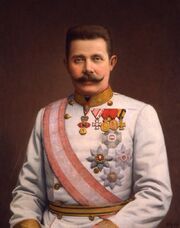| The following page is under construction.
Please do not edit or alter this article in any way while this template is active. All unauthorized edits may be reverted on the admin's discretion. Propose any changes to the talk page. |
NOTE: this page is entire timeline is now going under a huge renovation, and rewriting it from scratch. I will most likely starting a new page for it in the future, and hopefully making it make more sense. Thank you for your interest. Tbguy1992; Talk; Blog 20:46, February 25, 2017 (UTC)

Archduke Franz Ferdinand
On 28 June, 1914, the Heir to the Austro-Hungarian throne Archduke Franz Ferdinand was on a tour of Sarejevo, the capital of the recently annexed territory of Bosnia. Although Austria-Hungary had been administrating the territory since the 1878 Treaty of Berlin in the name of the Ottoman Empire, in 1909 Vienna announced that Bosnia was to be directly annexed by the Empire, sparking outrage across Eastern Europe and nearly leading to war between Austria-Hungary and Russia. However, diplomacy and calm heads including the aged Emperor, Franz Joseph, would settle the issue.
To the south of Bosnia was the Kingdom of Serbia. The assassination of King Alexander I Obrenović and his wife in 1903 lead to a more nationalistic and antagonistic monarch, King Peter I, being placed on the throne by the conspirators lead by Dragutin Dimitrijević. For the next 11 years, every opportunity that presented itself was used as an excuse to expand Serbia, to unify the Serbs who were mostly living in either the "sick man of Europe", the Ottoman Empire, or the multicultural lands of the Hapsburg Empire. While Serbia got little out of the 1909 crisis, the Balkan Wars of 1912-13 against first the Ottoman Empire, and second against Bulgaria, lead to Serbia doubling its size and causing fear in Vienna, with many military officers demanding a pre-emptive strike.
So as Archduke Ferdinand and his wife Sophie traveled to Sarajevo, the region was a flashpoint, waiting to be set off. In fact, as they drove through the city, a bomb was thrown at the Archduke's car, but it bounced off and landed under a second car in the convoy, which then exploded. Archduke Ferdinand decided to cut his trip short at the advice of his advisers, and he left for Vienna later that afternoon by train.
The near assassination attempt was considered a pivotal moment in history. Had the Archduke been assassinated in 1914, it could have set all of Europe at war. However, as the would-be assassins were never discovered, there was no way that anyone could identify who would have done such a thing. Therefore, Europe enjoyed yet another year of peace.
All thanks to One Day in Sarajevo.
Links[]
Timeline[]
Geopolitics[]
Wars[]
- Irish Insurrection (1914-1916)
- Austria-Hungarian Civil War (1917-1920)
- Great War (1917-1921)
- Russian Civil War (1921-1924)
- Sino-Japanese War (1930-1934)
